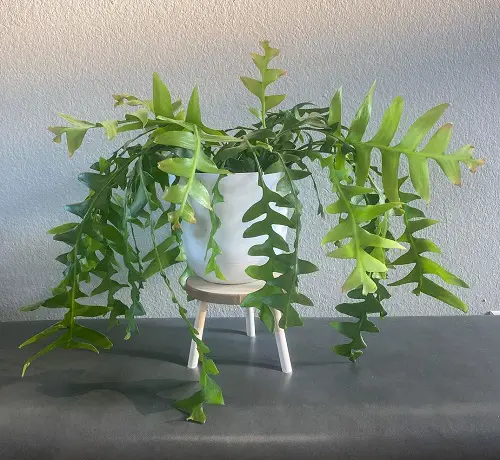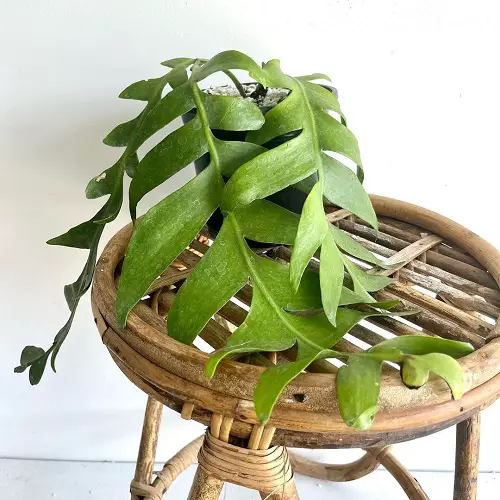Fern Leaf Cactus can be an excellent addition to your plant collection. Thanks to its serrated foliage and vibrant, golden-yellow blooms.

Fern Leaf Cactus Care can be somewhat challenging, but it’s worth the effort as the plant looks so smashing with all kinds of decor!
Learn how to grow red ferns
Fern Leaf Cactus Information
Fern Leaf Cactus (Mammillaria crinita) is a species of cactus native to Central Mexico. It is an evergreen succulent with a rounded, clumping form and a thick-stemmed, spiny structure.
The plant produces small, white flowers with yellow centers during the spring and summer months. The leaves of the Fern Leaf Cactus are a deep green color with a fern-like texture. The plant is drought-tolerant and requires little maintenance.
Propagating Fern Leaf Cactus
To propagate from seeds, plant the seeds in a well-draining soil mix. Water the soil lightly and keep it in a warm, bright location. The seeds should germinate within 4-6 weeks.
To propagate a fern leaf cactus through offsets, gently remove the offsets from the mother plant with a sharp knife or scissors. Place the offsets in a well-draining soil mixture and water them lightly. Place them in a warm, bright spot and keep them lightly moist but not wet. The offsets should form roots and begin to grow in about 6 to 8 weeks.
You can also grow the plant using cuttings.
Best Container Size for Growing Fern Leaf Cactus

It is best grown in a container that is at least 6-8 inches in diameter. Make sure it has drainage holes at the bottom.
Look at the Best Drought Tolerant Ferns
Requirements for Growing Fern Leaf Cactus

Sunlight
Fern Leaf Cactus thrives in bright but indirect sunlight. Place it in a well-lit room, but avoid direct sunlight as it can damage the leaves.
If you notice that the leaves are turning yellow or brown, it could be a sign of too much sun exposure. In this situation, shift the plant to a shadier place.
Exposing it to the mild morning sun for 2-3 hours will be a good idea.
Watering
When it comes to watering Fern Leaf Cactus, it is essential to avoid overwatering. As a general rule, water this cactus every 2-3 weeks during the spring and summer months and once a month during the cooler months.
Allow the soil to dry out completely between waterings. Over-watering can cause root rot, so err on the side of caution.
Soil
Fern Leaf Cactus needs well-draining, slightly acidic soil. A good mix would be equal parts potting soil, sand, and perlite or pumice.
You can also add a small amount of compost or aged manure to provide extra nutrients. Make sure to use a light potting mix to prevent the soil from becoming too soggy.
Temperature
The ideal temperature range is between 65-75°F (18-24°C). It prefers warm temperatures but can tolerate temperatures as low as 50°F (10°C) for short periods of time.
It is important to protect the Fern Leaf Cactus from any drastic temperature changes or temperatures above 85°F (29°C).
Check out Ferns for Containers
Fern Leaf Cactus Care

Fertilizer
Fern Leaf Cactus does not need much fertilizer, and it is best to feed it only once a year in the springtime. A balanced fertilizer, such as one with an N-P-K ratio of 10-10-10, is a good choice.
Dilute the fertilizer to half the recommended strength and apply it to the soil around the plant. Be sure to water well after fertilizing.
Pests and Diseases
Common pests of Fern Leaf Cactus include aphids, mealybugs, scale insects, and spider mites. These pests can be controlled by combining cultural and chemical control methods.
Cultural Control:
- Keep plants free of debris and debris-infested soil.
- Make sure plants are not overwatered.
- Increase air circulation around plants.
- Remove affected leaves and discard them in the trash.
Chemical Control:
- Insecticidal soaps can be used to control aphids, mealybugs, and scale insects.
- Neem oil can also be used to control aphids, mealybugs, and scale insects.
- Horticultural oils can be used to control spider mites.
- Systemic insecticides can be used to control aphids, mealybugs, and scale insects.
Fungal infections can appear as brown spots on the leaves and stems. The best way to treat this is to remove any affected parts and then spray the plant with a fungicide.
Root rot is caused by too much moisture and can cause the roots of the cactus to turn black and mushy. The best way to treat this is to carefully remove any affected roots and repot the cactus in fresh, sterile soil.
Tip: Make sure to allow the soil to dry out between waterings and use a pot with drainage holes to prevent future root rot.


